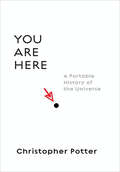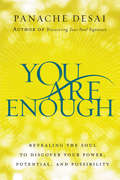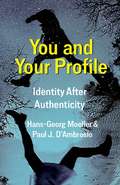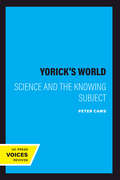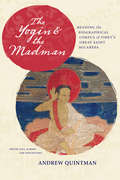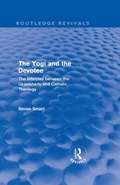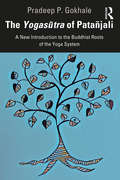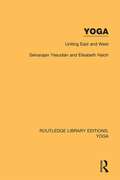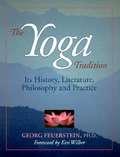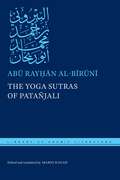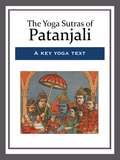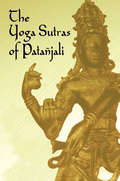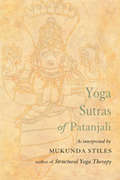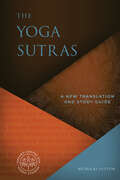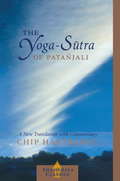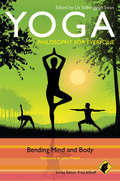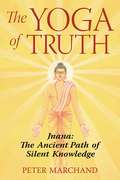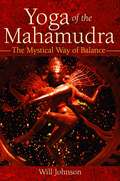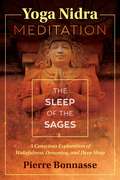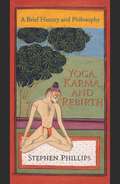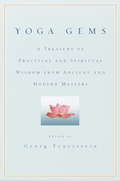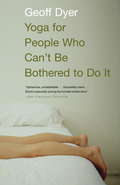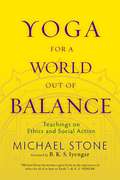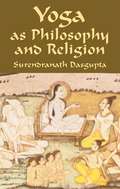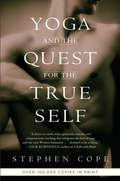- Table View
- List View
You Are Here: A Portable History of the Universe
by Christopher Potter“You Are Here is not just physics for poets, but as close to poetry or music as science is ever likely to get. Christopher Potter’s narrative is as imaginative, ingenious, and elegantly concise as it is user-friendly.” — Sylvia Nasar, author of A Beautiful Mind“A personal, brilliant, and often amusing account . . . . An idiosyncratic, encyclopedic blitzkrieg of a book.” —The Boston Globe“The Verdict: Read.” — TimeChristopher Potter’s You Are Here is a lively and accessible biography of the universe—how it fits together and how we fit into it—in the style of science writers like Richard Dawkins, Bill Bryson, and Richard Feynman, as seen through the lens of today’s most cutting-edge scientific thinking.
You Are Enough: Revealing the Soul to Discover Your Power, Potential, and Possibility
by Panache DesaiA spiritual thought-leader and featured guest on Oprah’s SuperSoul Sunday helps us learn to quiet fear and anxiety and discover the powerful wholeness that exists within us all in this inspiring and affirmative guide.Achieving equilibrium in today’s age of anxiety can seem like a near-impossible—even frivolous—task. Panache Desai offers a refreshing, surprisingly unusual approach to meet the challenges of the modern moment and heal the fractured self it produces.For Desai, the soul—whole, unbroken, at peace, and one with the life source—isn’t a destination. It already exists within each of us, just waiting to be revealed. It is not something we have to work to develop—it is our birthright. And when we are in union with our soul, we experience a personal evolution that not only illuminates our individual cosmic purpose but helps us to engage the sense of purpose and presence necessary to remake the world itself.You Are Enough offers a straightforward, non-judgmental, and approachable process of revealing the soul, of coming into alignment and harmony with our true selves. Combining personal narrative, clear and inspiring philosophy, and prescriptive practices, it reveals that the way through is the way in—that the way through fear, self-doubt, and anxiety is accepting and embracing dissonance and emotional and psychological blockages, so that we can approach our lives and the world from a perspective that understands our fears are not who we are. Desai’s goal is simple: to guide readers through radical self-acceptance toward a life of ultimate peace and fulfillment.Beautifully designed, this enlightening volume by a fresh voice shows us that while life may have caused us to forget our power, potential, light, and love, they are always there, just waiting to be discovered.
You and Your Profile: Identity After Authenticity
by Hans-Georg Moeller Paul J. D'AmbrosioMore and more, we present ourselves and encounter others through profiles. A profile shows us not as we are seen directly but how we are perceived by a broader public. As we observe how others observe us, we calibrate our self-presentation accordingly. Profile-based identity is evident everywhere from pop culture to politics, marketing to morality. But all too often critics simply denounce this alleged superficiality in defense of some supposedly pure ideal of authentic or sincere expression.This book argues that the profile marks an epochal shift in our concept of identity and demonstrates why that matters. You and Your Profile blends social theory, philosophy, and cultural critique to unfold an exploration of the way we have come to experience the world. Instead of polemicizing against the profile, Hans-Georg Moeller and Paul J. D’Ambrosio outline how it works, how we readily apply it in our daily lives, and how it shapes our values—personally, economically, and ethically. They develop a practical vocabulary of life in the digital age. Informed by the Daoist tradition, they suggest strategies for handling the pressure of social media by distancing oneself from one’s public face. A deft and wide-ranging consideration of our era’s identity crisis, this book provides vital clues on how to stay sane in a time of proliferating profiles.
Yorick's World: Science and the Knowing Subject
by Peter CawsPeter Caws provides a fresh and often iconoclastic treatment of some of the most vexing problems in the philosophy of science: explanation, induction, causality, evolution, discovery, artificial intelligence, and the social implications of technological rationality.Caws's work has been shaped equally by the insights of Continental philosophy and a concern with scientific practice. In these twenty-eight essays spanning more than a quarter of a century, he ranges from discussions of the work of French philosopher Gaston Bachelard, to relations between science and surrealism, to the concept of intentionality, to the limits of quantitative description. A lively mix of history, theory, speculation, and analysis, Yorick's World presents a vision of science that includes human history and social life. It will interest professional philosophers and scientists, and at the same time its directness will make it readily accessible to nontechnical readers.
The Yogin and the Madman: Reading the Biographical Corpus of Tibet's Great Saint Milarepa (South Asia Across the Disciplines)
by Andrew QuintmanTibetan biographers began writing Jetsun Milarepa's (1052–1135) life story shortly after his death, initiating a literary tradition that turned the poet and saint into a model of virtuosic Buddhist practice throughout the Himalayan world. Andrew Quintman traces this history and its innovations in narrative and aesthetic representation across four centuries, culminating in a detailed analysis of the genre's most famous example, composed in 1488 by Tsangnyön Heruka, or the "Madman of Western Tibet." Quintman imagines these works as a kind of physical body supplanting the yogin's corporeal relics.
The Yogi and the Devotee: The Interplay Between the Upanishads and Catholic Theology (Routledge Revivals)
by Ninian SmartFirst published in 1968, Ninian Smart’s The Yogi and the Devotee: The Interplay Between the Upanishads and Catholic Theology is based on lectures given in Delhi and explores in a novel way the relation between Hinduism and Christianity. The author puts forward a general theory of the relationship between religious experience and doctrines, a theory he had developed in earlier works. He argues that a new form of ‘natural theology’ should be presented, which would show the relevance of religious experience and ritual to what is given in revelation. Smart believes this could be the key to a new understanding between Christianity and Indian religions, and also examines what Christians can learn from other faiths. During a career as a Professor of Religious Studies and Philosophy, Ninian Smart was hugely influential in the way Religious Studies was taught, not only in Britain but around the world.
The Yogasūtra of Patañjali: A New Introduction to the Buddhist Roots of the Yoga System
by Pradeep P. GokhaleThis book offers a systematic and radical introduction to the Buddhist roots of Pātañjala-yoga, or the Yoga system of Patañjali. By examining each of 195 aphorisms (sūtras) of the Yogasūtra and discussing the Yogabhāṣya, it shows that traditional and popular views on Pātañjala-yoga obscure its true nature. The book argues that Patañjali’s Yoga contains elements rooted in both orthodox and heterodox philosophical traditions, including Sāṅkhya, Jaina and Buddhist thought. With a fresh translation and a detailed commentary on the Yogasūtra, the author unearths how several of the terms, concepts and doctrines in Patañjali’s Yoga can be traced to Buddhism, particularly the Abhidharma Buddhism of Vasubandhu and the early Yogācāra of Asaṅga. The work presents the Yogasūtra of Patañjali as a synthesis of two perspectives: the metaphysical perspective of Sāṅkhya and the empirical–psychological perspective of Buddhism. Based on a holistic understanding of Yoga, the study explores key themes of the text, such as meditative absorption, means, supernormal powers, isolation, Buddhist conceptions of meditation and the interplay between Sāṅkhya and Buddhist approaches to suffering and emancipation. It further highlights several new findings and clarifications on textual interpretation and discrepancies. An important intervention in Indian and Buddhist philosophy, this book opens up a new way of looking at the Yoga of Patañjali in the light of Buddhism beyond standard approaches and will greatly interest scholars and researchers of Buddhist studies, Yoga studies, Indian philosophy, philosophy in general, literature, religion and comparative studies, Indian and South Asian Studies and the history of ideas.
Yoga: Exercises And Meditations For All The Year Round (Routledge Library Editions: Yoga #9)
by Selvarajan Yesudian Elisabeth HaichIn this book, first published in 1956, the two authors, representatives of two different worlds and two entirely different attitudes, explore the wide domain of Eastern and Western philosophy. They put forward the theory that it is in Yoga that the two worlds meet.
The Yoga Tradition: Its History, Literature, Philosophy and Practice
by Georg FeuersteinThe author is founder-director of the Yoga Research Center in Northern California and the author of 30 books on yoga. The present volume is a revised and greatly enlarged edition of the author's 1989 work, Yoga: The Technology of Ecstasy .
The Yoga Sutras of Patañjali (Library of Arabic Literature #68)
by Abū Rayḥān al-BīrūnīA brilliant cross-cultural Arabic interpretation of a key text of yoga philosophyThe Yoga Sutras of Patañjali is the foundational text of yoga philosophy to this day and is still used by millions of yoga practitioners and students worldwide. Written in a question-and-answer format, The Yoga Sutras of Patañjali deals with the theory and practice of yoga and the psychological question of the liberation of the soul from attachments.This book is a new edition and translation into English of the Arabic translation and commentary on this text by the brilliant eleventh-century polymath al-Bīrūnī. Given the many historical variants of the Yoga Sutras, his Kitāb Bātanjali is important for yoga studies as the earliest translation of the Sanskrit text. It is also of unique value as an Arabic text within Islamic studies, given the intellectual and philosophical challenges that faced the medieval Muslim reader when presented with the intricacy of composition, interpretation, and allusion that permeates this translation.A bilingual Arabic-English edition.
The Yoga Sutras of Patanjali
by PatanjaliThe 'Yoga Sūtras of Patañjali' are 196 Indian sūtras (aphorisms) that constitute the foundational text of Ashtanga Yoga, also called Raja Yoga. In medieval times, Ashtanga Yoga was cast as one of the six orthodox āstika schools of Hindu philosophy.
The Yoga Sutras of Patanjali
by Patañjali James Haughton WoodsOne of yoga's most important and influential works, The Yoga Sutras of Patañjali forms a keystone of Indian philosophical and religious thought. Written by a sage in the second century B.C., the sutras have been translated many times. This interpretation by Professor James Haughton Woods, originally published under the aegis of the highly esteemed Harvard Oriental Series, ranks among the most acclaimed translations.Patañjali's path is that of Raja Yoga, the royal yoga, or the yoga of the eight steps: restraint, observances, posture, breath control, sublimation (or withdrawal from the senses), attention, concentration, and meditation. The complete sutras appear here, encompassing a four-part analytical study intended to purify the practitioner's mind, body, and soul. Additional features include a commentary by Veda-Vyāsa and explanations by Vāchaspati-Miҫra that are crucial to developing an understanding of Patañjali's intent, along with invaluable background information provided by the translator's introduction and appendixes.This outstanding English edition of a profound work of spiritual enlightenment is essential reading for all scholars and practitioners of yoga.
Yoga Sutras of Patanjali
by Mukunda StilesThis is an English rendering of the classical text on yoga and meditations that maintains the poetic forms of the sutras. Patanjali is to Yoga what Buddha is to Buddhism. His sutras-scriptural narratives sometimes defined as literally "the path to transcendence"- are a darshan, or philosophical worldview and method to aid the awakening of self-realization. Patanjali reveals a set of landmarks that enable practitioners to lift the veils and study the hidden self, eventually following this path to enlightenment.
The Yoga Sutras: A New Translation and Study Guide
by Nicholas SuttonThis short course sets out a detailed study of the text, philosophy, and significance of the millennia-old yoga system defined in the Yogasutras. The popular practice of yoga finds its origin in one of the most venerated wisdom books of India: the Yogasutras. Comprised of 196 short statements on the essential teachings of yoga, Patanjali&’s Yogasutras holds the position of being the seminal work that defines the yoga system. Over the centuries many important commentaries have been written that seek to explain and extrapolate the full meaning of the sutras, and to this day, the text continues to be appreciated for the profound wisdom contained within it. While the Yogasutras were originally written in Sanskrit, this short course offers an accessible translation and commentary without sacrificing any of its profound wisdom. This edition will allow the reader to study and dive into the meaning and philosophy of this ancient text with its significant contemporary relevance. Yoga students, practitioners, and scholars alike will appreciate the way in which this short course guides the reader through the text.
The Yoga-Sutra of Patanjali: A New Translation with Commentary
by Chip HartranftIn just 196 short aphorisms, this classic work of Indian philosophy spells out succinctly how the mind works, and how it is possible to use the mind to attain liberation. Compiled in the second or third century CE, the Yoga-Sutra is a road map of human consciousness--and a particularly helpful guide to the mind states one encounters in meditation, yoga, and other spiritual practices. It expresses the truths of the human condition with great eloquence: how we know what we know, why we suffer, and how we can discover the way out of suffering. Chip Hartranft's fresh translation and extensive, lucid commentary bring the text beautifully to life. He also provides useful auxiliary materials, including an afterword on the legacy of the Yoga-Sutra and its relevance for us today.
Yoga - Philosophy for Everyone: Bending Mind and Body (Philosophy for Everyone #41)
by Liz Stillwaggon SwanStimulates thoughts and expands awareness of the philosophical dimensions of yoga in its many forms and practices Yoga — Philosophy for Everyone presents a wide array of perspectives by people whose lives have been touched by yoga. Addressing myriad aspects of yoga's divergent paths, topics include body image for men and women; the religious and spiritual aspects of yoga; and issues relating to ethics, personal growth, and the teaching of yoga. Written by philosophers and non-philosophers alike, with contributions from professional yoga instructors, lifelong practitioners, and first-timers, Yoga — Philosophy for Everyone offers a wealth of material for both enjoyment and deep reflection.
The Yoga of Truth: The Ancient Path of Silent Knowledge
by Peter MarchandA guide to Jnana Yoga--the Way of Silent Knowledge--by direct contemplation of the Unchangeable • Shows that everything in one’s body, personality, thoughts, memories, and experiences has form and is changeable and, thus, is neither essential nor eternal • Identifies the witnessing consciousness within--all that remains when the ephemeral is eliminated--as the real Self, the one and only unchanging eternal Being In The Yoga of Truth, Peter Marchand, through a series of deceptively simple introspective questions, leads the seeker into discarding everything--body, personality, thoughts, memories, experiences--that disguises the ego’s relentless masquerade as the Self. This form of contemplation, with its constant commitment to witnessing without attachment, disempowers the ego’s fixation on its products, leading instead to the realization that the witnessing consciousness is, in fact, the one immutable Being within or without--the real Self, the true You. The universal illusion rests upon space and time, body and elements, the life force, mind, intellect, ego, and Self. Jnana Yoga reveals not only the insubstantial and illusory nature of our presumptions but also our habitual commitment to the illusion of being an individual that they create. This illusion collapses like a house of cards before direct inspection. When something has form, when it can change, it cannot be the eternal with which we seek union. Witnessing consciousness stands alone as that which is without form. In The Yoga of Truth, Marchand leads us simply, and compellingly, to the truth of our nature and the peaceful bliss of true Being.
Yoga of the Mahamudra: The Mystical Way of Balance
by Will JohnsonPresents three simple yogic principles from Tilopa's Song of Mahamudra• Explains how balance is the key to achieving higher consciousness• Includes somatic koansMahamudra, literally "the great gesture," is often looked upon as the highest manifestation of consciousness known within the Tibetan Vajrayana tradition. In Yoga of the Mahamudra, Will Johnson explains how it is possible to bring forth the condition of mahamudra naturally by utilizing the mystical yoga of balance to create what he calls the embodied cross. He presents three simple yogic principles from Tilopa's Song of Mahamudra. The first principle, "do nothing with the body but relax," forms the vertical axis of the embodied cross. It is an internal process that focuses on the upright structure of the body, which opens up our relationship to the divine source. The second principle, "Let the mind cling to nothing," allows the horizontal flow of energy to our mind. This horizontal axis represents our relationship to the world: what we see and hear, and what our mind does with the objects we perceive. The establishment of these vertical and horizontal flows of energy allows us to embody the third principle, "to become like a hollow bamboo." In this way the body and mind become extraordinarily fluid, surrendering to the currents of the life forces that constantly flow through them like air through a flute. The author concludes with a number of somatic koans, exercises that allow the direct experience of balance and lead to the creation of the embodied cross.
Yoga Nidra Meditation: The Sleep of the Sages
by Pierre BonnasseA practice to consciously explore wakefulness, dreaming, deep sleep, and the very structure of your emotional, mental, and energy bodies • Details the simple postures of Yoga Nidra, breathing exercises and guided meditations, and tips for maintaining awareness in the liminal state that precedes sleep • Explains how Yoga Nidra allows you to explore different states of consciousness and any blockages in the emotional, mental, and energy bodies • Includes four complete sessions as well as pointers for creating your own sessions Known as the “yoga of conscious sleep,” Yoga Nidra is an ancient Indian practice that allows you to consciously explore the states of wakefulness, dream, and deep sleep as well as your own psyche by combining deep relaxation with attentive awareness. Stemming from Hindu, Buddhist, and Tantric philosophies, the practice--which could be called the “sleep of the sages”--centers on techniques for putting the mind and body to sleep while keeping your consciousness alert. Through Yoga Nidra you can directly observe and understand specific physiological, emotional, and mental processes within yourself as well as experience moments of great inner tranquility, joy, and well-being. Providing a step-by-step guide to Yoga Nidra, Pierre Bonnasse offers a full range of practices focused on the time of awakening and that of going to sleep, yet adaptable to any time of day or night. He details the simple postures of Yoga Nidra and includes preparatory techniques that work with breath and guided meditations to help you become an attuned observer of your inner world. Offering tips for withdrawing the senses and maintaining awareness in the liminal state that precedes sleep, the author explores how all practices in this discipline begin with a phase of relaxation and observation of breathing, followed by immersion into a very subtle awareness of the physical, energy, and mental bodies. He explains how Yoga Nidra sessions allow you to discover “that which is held on to,” making it is easier to let go and become free from all states and processes. A session can explore different states of consciousness as well as your senses, desires, and fears. The higher states of more advanced sessions focus on the energy body and its components: the chakras, nadis, and pranavayu, the vital breath and autonomic functions of the body. Including four complete sessions as well as pointers for creating your own, Bonnasse shows how Yoga Nidra offers positive, stabilizing, and therapeutic effects for the body, emotions, and thoughts. It is the ideal practice for getting rid of stress, anxiety, and the fear of death the source of all other fears. Connecting Indian and Western philosophical ideas, the author shows how sleep can be an opportunity to practice a form of yoga that changes not only our nights but every minute of our days.
Yoga, Karma, and Rebirth: A Brief History and Philosophy
by Stephen PhillipsFor serious yoga practitioners curious to know the ancient origins of the art, Stephen Phillips, a professional philosopher and sanskritist with a long-standing personal practice, lays out the philosophies of action, knowledge, and devotion as well as the processes of meditation, reasoning, and self-analysis that formed the basis of yoga in ancient and classical India and continue to shape it today. In discussing yoga's fundamental commitments, Phillips explores traditional teachings of hatha yoga, karma yoga, bhakti yoga, and tantra, and shows how such core concepts as self-monitoring consciousness, karma, nonharmfulness (ahimsa), reincarnation, and the powers of consciousness relate to modern practice. He outlines values implicit in bhakti yoga and the tantric yoga of beauty and art and explains the occult psychologies of koshas, skandhas, and chakras. His book incorporates original translations from the early Upanishads, the Bhagavad Gita, the Yoga Sutra (the entire text), the Hatha Yoga Pradipika, and seminal tantric writings of the tenth-century Kashmiri Shaivite, Abhinava Gupta. A glossary defining more than three hundred technical terms and an extensive bibliography offer further help to nonscholars. A remarkable exploration of yoga's conceptual legacy, Yoga, Karma, and Rebirth crystallizes ideas about self and reality that unite the many incarnations of yoga.
Yoga Gems
by Georg FeuersteinA blend of physical, mental, and spiritual traditions, Yoga aims to forge a union between mind and body as a means to spiritual enlightenment and true inner peace. There are now 18 million Yoga practitioners in the United States, a jump of 6 million in the last decade alone, and 74 percent of fitness clubs offer Yoga classes. For enthusiasts as well as beginners, this calendar sheds light on the rich philosophical and spiritual tradition behind the exercises. Each page offers an inspirational thought, gathered from sources both ancient and modern by one of America's most respected Yoga scholars, on such topics as inner growth, the value of silence, remembering and cultivating one's true inner self, developing self-discipline, and bringing out the good in all one says and does. The" Yoga Gems 2004 Calendar is the perfect travel companion on the road to spiritual enlightenment and true inner peace.
Yoga for People Who Can't Be Bothered to Do It
by Geoff DyerThis isn't a self-help book; it's a book about how Geoff Dyer could do with a little help. In mordantly funny and thought-provoking prose, the author of Out of Sheer Rage describes a life most of us would love to live--and how that life frustrates and aggravates him.As he travels from Amsterdam to Cambodia, Rome to Indonesia, Libya to Burning Man in the Black Rock Desert, Dyer flounders about in a sea of grievances, with fleeting moments of transcendental calm his only reward for living in a perpetual state of motion. But even as he recounts his side-splitting misadventures in each of these locales, Dyer is always able to sneak up and surprise you with insight into much more serious matters. Brilliantly riffing off our expectations of external and internal journeys, Dyer welcomes the reader as a companion, a fellow perambulator in search of something and nothing at the same time.From the Trade Paperback edition.
Yoga for a World Out of Balance: Teachings on Ethics and Social Action
by Michael StoneUsing the five principles (yama) described in the Yoga-Sutra attributed to Patanjali, Michael Stone offers a basis for rethinking ethical action and the spiritual path.
Yoga as Philosophy and Religion (Trubner's Oriental Ser.)
by Surendranath DasguptaA practical guide by an experienced teacher, this book shows how the highest form of yoga, the Rājayoga espoused by the great sage Patanjali, serves as a path to the kind of mental steadiness that ultimately yields self-realization. It explains the foundation of yoga practices — their philosophical, psychological, cosmological, ethical, and religious doctrines — and compares the essential features of Rājayoga with other yoga systems.The first of its two parts deals with yoga metaphysics, delineating the characteristics and functions of Prakrti and Purusa, the reality of the external world, and the process of evolution. The second part expounds yoga ethics and practice, with emphasis on yoga method, stages of samādhi, and related topics.Both beginners and experienced yoga practitioners will find this classic volume a useful and inspiring reference.
Yoga and the Quest for the True Self
by Stephen CopeMore than 100,000 copies sold!Millions of Americans know yoga as a superb form of exercise and as a potent source of calm in the midst of our stress-filled lives. Far fewer are aware of the full promise of yoga as "the way of the fully alive human being"--a 4,000-year-old practical path of liberation that fits the needs of modern Western seekers with startling precision.Now one of America's leading scholars of yoga psychology--who is also a Western-trained psychotherapist--offers this marvelously lively and personal account of an ancient tradition that promises "the soul awake in this lifetime." Drawing on the vivid stories of practitioners at the largest yoga center in America, where he has lived and taught for more than ten years, Stephen Cope describes the philosophy, psychology, and practice of yoga--a practical science of development that urges us not to transcend or dissolve the self, but rather to encounter it more deeply.In this irreverent modern-day Pilgrim's Progress, Cope introduces us to an unforgettable cast of contemporary seekers--on the road to enlightenment carrying all the baggage of the human condition: confusion, loss, disappointment, addiction, and the eternal conflicts around sex and relationship. As he describes the subtle shifts of energy and consciousness that happen at each stage of the path, we discover that in yoga, "liberation" does not require us to leave life in the world for some transcendent spiritual plane. Life itself is the path.Above all, Cope shows how yoga can heal the suffering of self-estrangement that pervades our society, leading us to a new sense of purpose and to a deeper, more satisfying life in the world.
